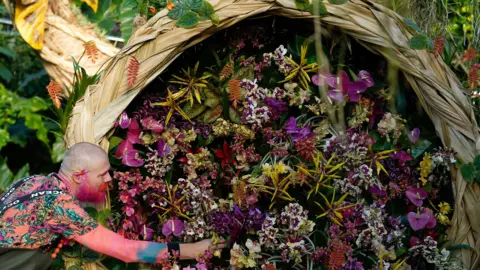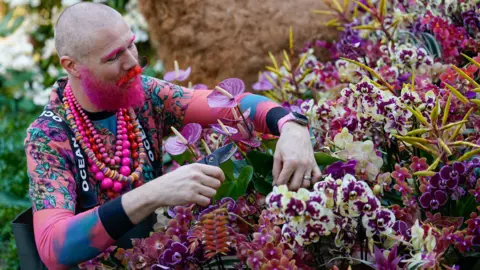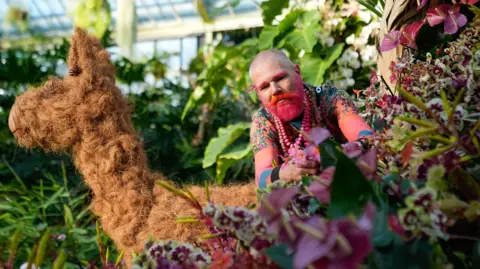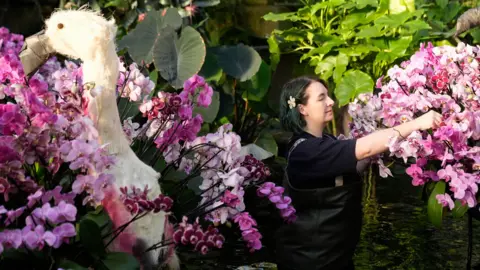Kew celebrates Peru with colourful orchid display
 PA Media
PA MediaFlamboyant flora has taken over Kew Gardens for its annual orchid display.
Described as "a breath-taking cornucopia", the focus for this year is Peru, with the central installation "reminiscent of Lake Titicaca".
The world's largest bromeliad, the Puya raimondii (commonly known as the queen of the Andes) is displayed alongside floral sculptures.
The plant is classified as endangered in the wild by the International Union for Conservation (IUCN).
 PA Media
PA MediaThe Peru exhibition is in the Princess of Wales Conservatory, and keen floraphiles should be able to tick a number of rare plants off their checklist:
- Passiflora venusta - named as new to science in 2007, was previously misidentified as another species in the 1920s.
- Browningia hertlingiana, a cactus commonly known as blue cereus found on the slopes of the dry forests of the Andean valleys. It produces blue side shoots with sharp spines and can grow as tall as 8m (26ft).
- Costus vargasii, commonly known as the spiral ginger or raspberry yogurt plant because of its vibrant red inflorescence (a cluster of flowers arranged on a plant's stem) which usually appears in the summer. It has long and glossy leaves which are dark green on the top, and deep purple underneath. These spiral out and circle as the plant grows, and it can reach up to 2m (6ft) in height.
- Gorgonidium intermedium, a member of the aroid family. It produces a solitary leaf and a vibrant maroon red spadix (a type of inflorescence having small flowers borne on a fleshy stem). It grows primarily in the seasonally dry tropical biome, one of the most threatened ecosystems in Peru, and one which is under increasing pressure due to climate change.
- Sanchezia stenomacra, commonly known as the blood red feather, is at home in the jungles of Peru. It thrives in humid environments with filtered light. It produces blood red flowers which look just like feathers, and in the wild it is pollinated by hummingbirds and butterflies.
- Pamianthe peruviana, commonly known as the giant Peruvian daffodil is native to the seasonally dry areas of Peru and Bolivia. Like orchids, it is an epiphyte, which means that it grows on the surface of another plant or tree rather than in the soil and absorbs water and nutrients from the air. It produces enormous white flowers which are highly scented. It is believed to be extinct in the wild but is represented in several living collections around the world, including Kew Gardens.
 PA Media
PA MediaOther features of the display include an "orchid-aviary" that brings to life the diverse bird populations of Peru and an alpaca bedecked in orchids.
Elsewhere at Kew Gardens, visitors can wander beneath a starry night sky "adorned with dazzling allium flower heads which will be recycled from Kew's outdoor garden displays".
Which sounds jolly nice.
 PA Media
PA MediaDating back to 1759, the site was made a Unesco World Heritage Site in July 2003.
Kew's accessibility scheme means that for those in receipt of Universal Credit, Pension Credit and Legacy Benefits, tickets cost £1.
Listen to the best of BBC Radio London on Sounds and follow BBC London on Facebook, X and Instagram. Send your story ideas to [email protected]
